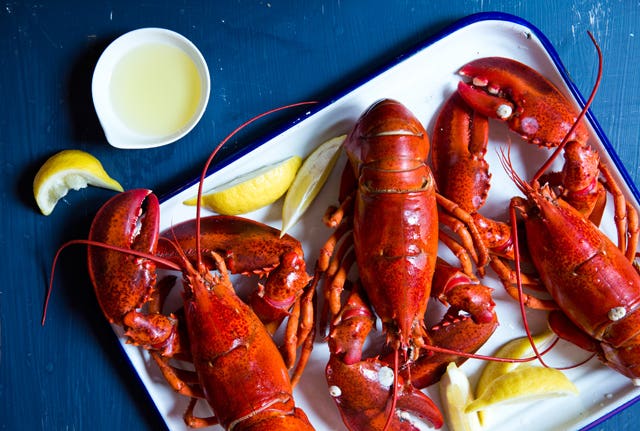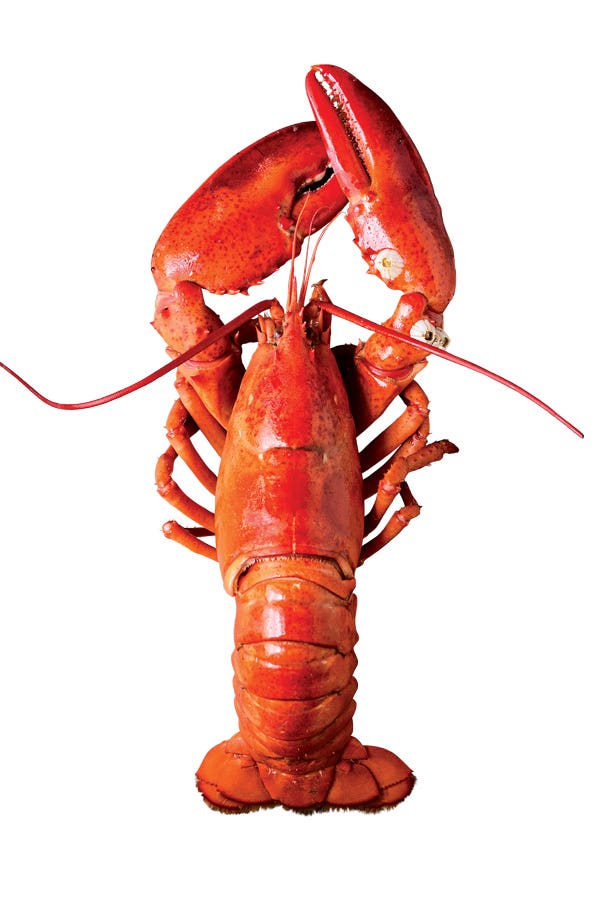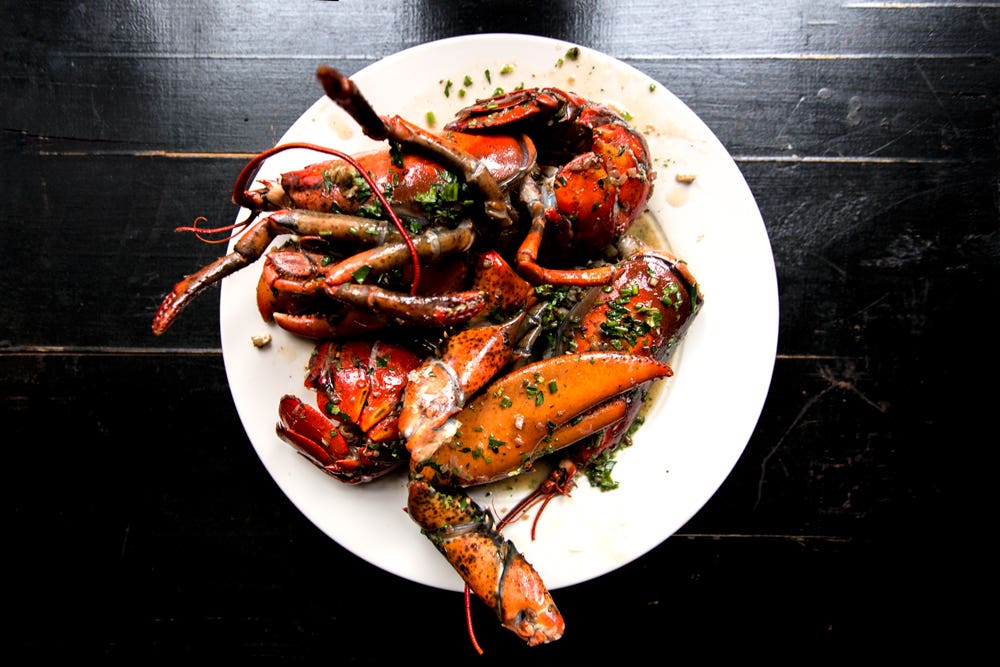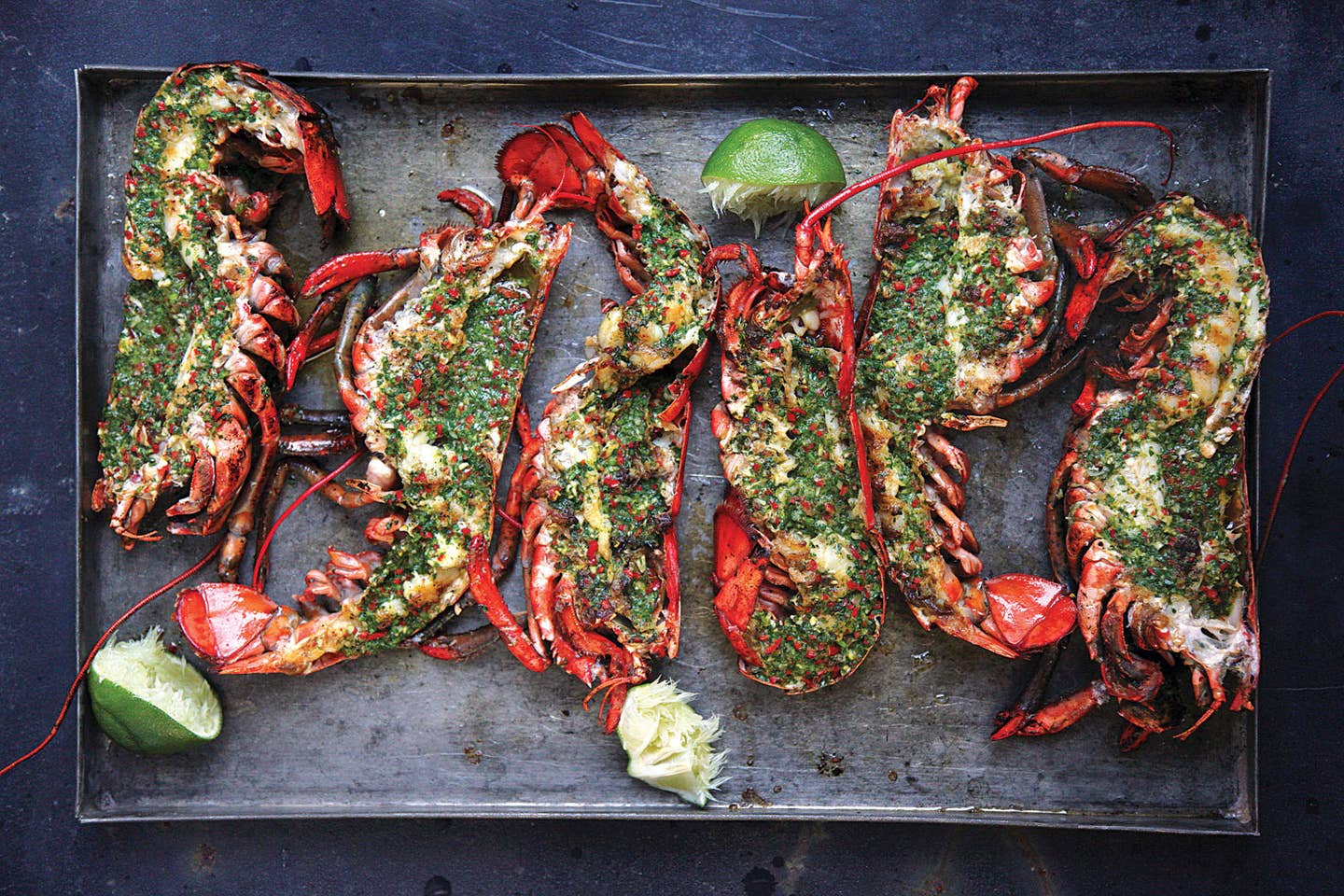
Uncle Lobster
Maine gained a culinary icon, they say, the day John D. Rockefeller was served a stew meant for the help.

There's not much tourist traffic through the coastal villages of the high Down East in far northeastern Maine. The principal attraction around here is the minimalism of sea and sky and landscape. That and the quiet, severe beauty of the region—a beauty hinted at by the flinty poetics of the local place names: Winter Harbor, Corea, Roque Bluffs, Beal's Island, Mt. Desert, Machiasport, Petit Manan.
Narrow roads wind through the sand-floored, scrub-pine woods to the stony promontories on which many of the villages sit. At the heart of each village is its harbor. Many of the houses are situated so that they look down upon the small wharves that extend out into the water, each one piled with the items required by the trade of lobster fishing—coils of rope, bait bags, netting, floats, and traps. Paths, wide and well trodden, connect the houses and the wharves—paths you could easily walk in the dark.
Which, if you're a lobsterman, is what you do. It's what I did when I was fishing, and it's the part that I now remember most strongly. I would head down to the wharf an hour or so before dawn, when the harbor was already echoing with the gentle cough and rumble of the big marine engines warming up. Light would just be starting to tinge the horizon as I stood at the edge of the dock, a cup of steaming coffee in my hands, listening to the surf against the outer bar as a clue to what it might be like out on the water that day. At such moments, I was very happy to be where I was.
I'd started as a sternman (i.e., helper) on the Land Shark, skippered by Kippy Young, a fourth-generation lobsterman based out of Corea. Young taught me much about the sea, and about the creature he called Uncle Lobster. I worked my way up to my own boat and two 75-trap lines, learning along the way that to be a lobsterman you must be either well capitalized or determined never to be anything but a lobsterman. I was neither, as it turned out, and so I am a lobsterman no longer.
But it was glorious while it lasted, the pursuit of Homarus americanus, the American lobster—also, and most famously, known as the Maine lobster—which is generally and properly considered to be the finest-eating crustacean the sea can offer.
In 1993, some 56 million pounds of lobster were taken from U.S. waters. More than half that was landed in Maine. Lobstering is practiced along 1,500 miles of Atlantic coastline, from Newfoundland to the Carolinas, but lobster is the essence of the Maine seacoast. Lobster and Maine are all but synonymous.
Oddly, how this came to be is something of a mystery. Since the early settlers of the Massachusetts Bay Colony were among the first Europeans to tie on the lobster bib—even documenting in their official record the large size and great numbers they fished—shouldn't we think of it as Massachusetts lobster?
If we don't, perhaps it's because the Pilgrims stopped eating lobster as soon as they could, preferring to consume creatures of a less unlikely appearance—and creatures which were not so cloyingly plentiful. It's all too easy to forget today, when lobsters are considered an expensive delicacy, but for centuries they were so abundant that they were usually considered food for the poor. At one point, colonists even crushed the lobsters and used them as fertilizer on potato fields.
According to one apocryphal tale, it was John D. Rockefeller Sr. who rescued Uncle Lobster from culinary ignominy. In 1910, the Rockefellers established a summer home on Mt. Desert Island. The legend is that a bowl of lobster stew meant for the servants' table was inadvertently sent upstairs—where it was rapturously received. Either unaware of the plebeian reputation of the dish, or not much caring what people thought, the master of the house gave it a permanent place on his menu. Back in New York, what was good enough for John D. was good enough for the Commodore, Andrew, and the rest of The 400—as long as it was made with Maine lobsters and only Maine lobsters. That's the story, anyway.
Those engaged in lobstering today reach uncommon agreement regarding what makes for the best-tasting lobster and how he is made ready for the table. "You want a snapper—one with some fight in him," according to Kippy Young. "One that when you pick him up, he snaps his tail a time or two. And then you boil him in fresh seawater." No grilling, no steaming—just a quick plunge into the bubbling pot. "Couple minutes is long enough. Bigger they are, the longer you cook. Myself, I'd rather eat two chicken [small] lobsters than one five-pounder. They say the big ones aren't tougher but I think they are. Course, I don't eat so many myself." (Which is true of many fishermen; like the candymaker who never eats chocolate, most lobstermen seldom partake of their haul.)
Grilled lobster is a popular dish in Boston, where shellfish from the Gloucester Seafood Display Auction is plentiful.
Lobster is economically the most important single species fished in North Atlantic waters. Given its economic importance, it's not surprising that Uncle Lobster has been the subject of extensive studies by scientists and researchers. But no one studies the lobster more assiduously than the lobsterman—whose craft is not so much fishing as it is the application of superstition, common knowledge, ingrained habit, and pure contrariness to the pursuit of the quarry.
This is not to suggest that all lobstermen think alike on the subject—far from it. Some are certain that under the water there exist lobster highways—aquatic thoroughfares, as it were, on which the lobster prefers to travel. Others believe those believers to be insane, sure as they are that lobsters go where lobsters go—which is to say anywhere and everywhere. (Lobsters do wander: A tagged female was once caught 180 miles from the place she last spent time in a trap.) Some lobstermen believe it's good luck to move their traps frequently; others never move them, quite sure that to do so courts ill fortune. They don't even agree on what kind of bait to use.
But every lobsterman starts early. "Best to get out on the water before the light," Young told me. "Pull your first pot a little before dawn. Uncle Lobster, he's out at night, you know, so maybe that's the time to catch him, right before he goes to bed." One lobsterman I knew liked to get out so early that he'd set off just as all the other lobstermen were coming in. "That's just the way he is," I was told, when I remarked that this seemed a bit excessive.
Most serious lobstermen fish between 300 and 1,000 traps, depending on the size of their boat and crew, and how much they're liked down at the local bank. Most of the old, wooden-lath traps have been replaced by newer ones made of wire on a metal frame—though the wooden ones are still piled photogenically on many wharves. The traps, metal or wood, are designed so that the lobster can easily enter the front chamber and get from there to the second one, where the bait is. Once he's there, it's hard for him to get out—but not impossible: If a trap is left unattended for more than 48 hours, it's usually empty when hauled up.
Traps are set on the sea floor at depths of anywhere from ten to 250 feet—and offshore lobstermen, whose boats stay out for days at a time, set traps at depths of up to 1,500 feet.

Filled traps used to be brought up by brute force. Today, a hydraulic winch, powered by the boat's engine, does the heavy lifting. The trap is opened, the lobsters are measured—a legal lobster in Maine must measure at least 3 1⁄4 inches and not more than 5 inches from eye socket to carapace—and rubber bands are slipped over their claws. The bait bag is refilled and the trap is closed and pushed over the side again, usually, with impeccable timing, just before the next trap on the line breaks the surface.
"You got to put out pots in the hundreds now," says Young, "just to keep up. More pots, more floats, more diesel, more time out on the water." The problem is that the per-pound dockside price for lobster, allowing for inflation, hasn't risen in pace with the price of diesel, rope, and so on. As a result of this economic squeeze, territory has become a hot issue. Down at Casco Bay one year, one fisherman hauled up a pipe bomb; another, on Long Island Sound, was shot on his boat. That hasn't happened yet in the high Down East, but nonnatives who talk dreamily of a life on the water are apt to be regaled with tales of mysterious boat fires and traplines cut loose from their floats.
Talk of a new marketing approach, one that would benefit lobstermen rather than brokers and middlemen, surfaces with increasing frequency. "More money would be nice," says Young. "Shouldn't be a subsistence living, not with what they charge for a lobster dinner in some places. But some things make up for it."
I know what he means. There was a morning out on the water when I stopped hauling to watch the sun rise. I poured some more coffee from the thermos and lit a cigarette, and as the sun broke free, a pod of pilot whales surfaced just 20 or 30 yards off the stern of the boat. The whole world was blue for a moment, the sky and sea a mirror of each other, and nothing was in it except the whales, the gulls, and myself. I brought two lobsters back with me that night and boiled them in seawater. I had never tasted anything so good before, and I probably never will again.
Keep Reading
Continue to Next Story












